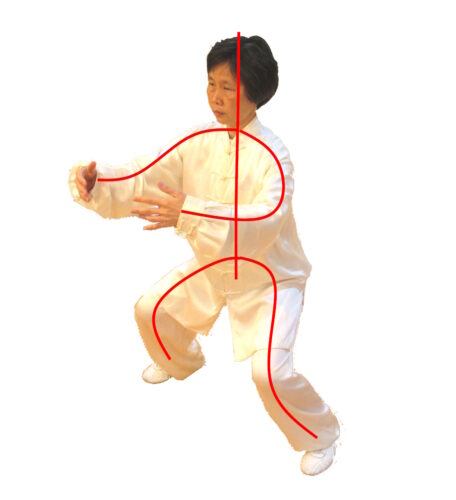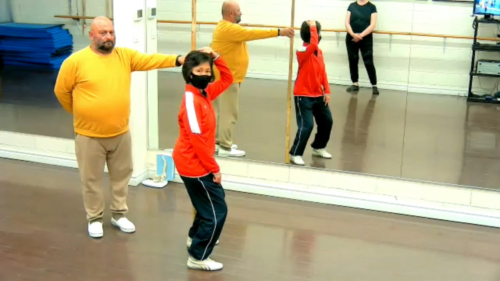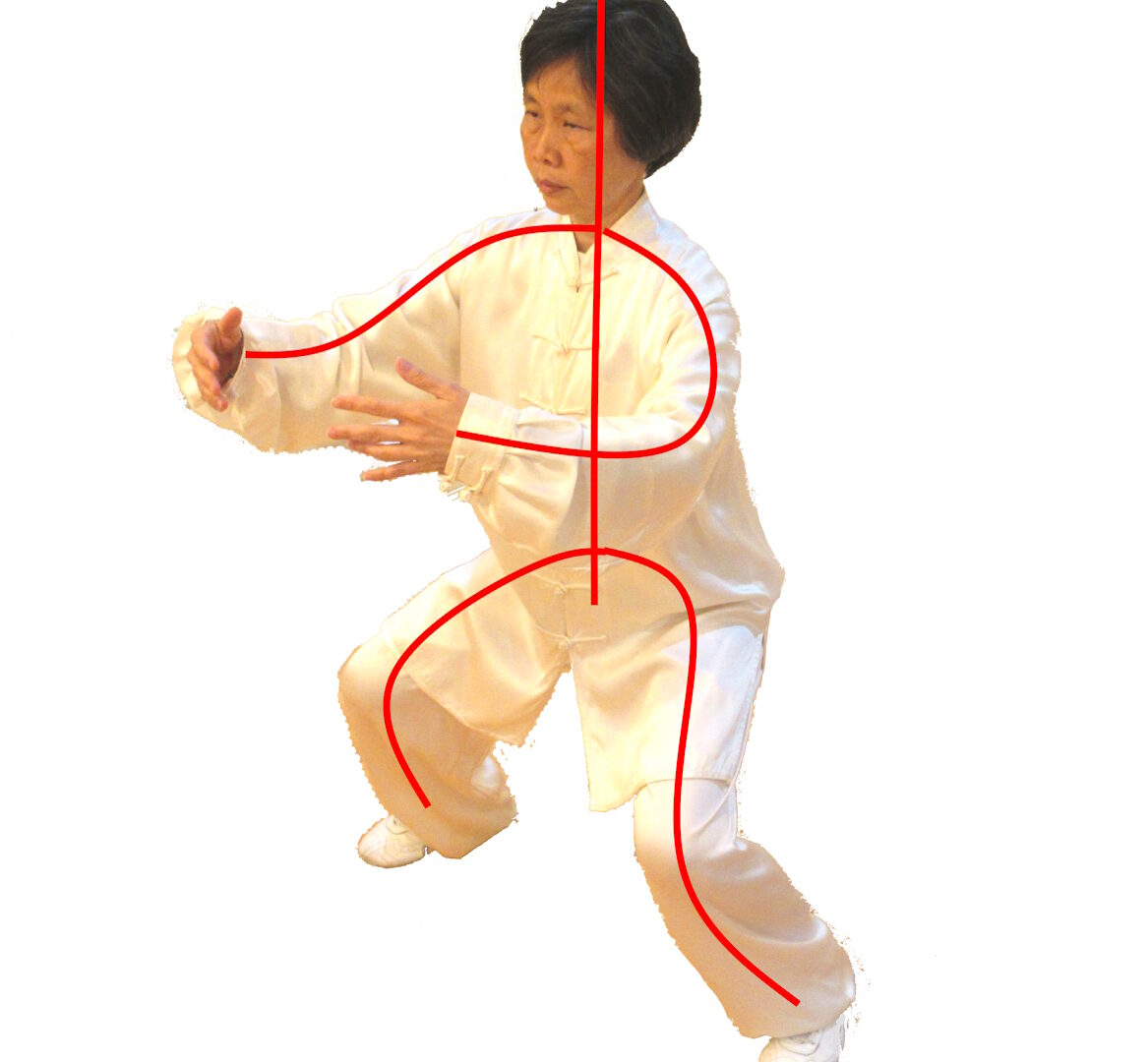Five Bow Theory
One of the first theories that we learn in our Tai Chi Basics class is the Five Bows, where we treat our body as if it is made up of bows, similar to those used in archery. The most important one, the main bow starts from the crown of the head (“Baihui” 百會) and runs down your spine to the tailbone. The two lower bows or leg bows, starts from the “Mingmen” 命門 (located directed opposite the navel), runs to the hips and down the legs to the centre of the feet (“Yongquan” 湧泉). The two upper bows or arm bows, starts from the base of your cervical spine C7 (“Dazhui” 大椎), runs to the shoulders and to the centre of the palms (“Laogong” 勞宮).
Throughout all the basic exercises, there is emphasis on NOT breaking any of the five bows. In the beginner classes, sometimes we focus on just one or two bows, but ultimately all five bows must remain intact at all times.

Elastic Power
The ability of a material to store energy when stretched and then release energy when springing back to its original state is known as elasticity. Tai Chi derives its power from elasticity, thus making its training methods fairly unique and unlike most other external martial arts.
The bones in our body are rigid, they can bear and transfer weight and pressure, but when subjected to excessive stress, they can fracture and break. Hence we are not able to derive elasticity from our bones, however, the rest of the soft tissues that make up the human body can become elastic with the ability to store and release energy.
First Requirement: RELAX
One of the key prerequisites of achieving elasticity in our body is to relax our muscle groups, making it soft and pliable. Tense muscles make our body rigid, losing its ability to stretch and store energy.
Before we learn how to relax our muscle groups, there is another prerequisite, a perfectly aligned posture. Our body is made up of many different muscle groups which can be broadly classified into opposing muscle groups, also known as agonist-antagonist muscle pairs. In order for these opposing muscle pairs to relax, we must first make sure our body is aligned, centred and balanced.

A body that is unbalanced or has poor posture means one group of muscles will have to work harder to prevent us from falling over. Over time, one muscle group will be over-used and stressed, while the opposing group will be under-used and become weaker. Having a good postural alignment is not just so we can relax our muscle groups better, it can also help relieve common aches and pains due to unbalanced muscle use typically in the neck, shoulders, back, hips and knees.
Second Requirement: STRETCH
Relaxation alone is not sufficient to create elasticity, the next step is to stretch. We want to stretch our postural muscles and this can be achieved by lengthening our five bows. The “tai chi state of readiness” is basically to maintain the five stretched bows.
There are several tai chi principles that directly explain what needs to be done to achieve this state.
- Lift the crown and hang the crotch (提頂吊襠)
- Empty the chest and solidify the abdomen (虛胸實腹)
- Hold in the chest and slightly pull the back (含胸拔背)
- Sink the shoulders and drop the elbows (沉肩墜肘)
- Pull in the groin and wrap the hips(收胯裹臀)
The first two principles correspond to the main bow. The first will align the posture straight and the second is to create the weight to pull and stretch the main bow, similar to how a plumbline works.
The third and fourth principles correspond to the arm bows. The third will pull the shoulder blades apart, the fourth will stretch the shoulders and elbows.
The last principle corresponds to the leg bows. Pulling in the groin will result in stretching the knees and wrapping the hips will stretch the pelvis.
Balancing motion with intent
Balance is probably the most well known aspect of tai chi, where it is typically explained using the Chinese philosophical concepts of Yin and Yang, there are many books and literature devoted to this topic alone. Hence the topic of Yin and Yang is considered an advanced principle introduced later when the student has achieved a certain level of fluency and understanding of tai chi.
At the beginner level, we introduce the following tai chi principle: “going forward with backward intention” (向前有後意), which may be understood literally as being mentally prepared to move backward as you are moving forward. But this explanation is too superficial and not necessarily correct.
We can explain it in simpler terms when combined with the five bow theory. Using our arm bows as an example, imagine grabbing the bow on its two ends and stretching it, you will need to apply force pulling the bow in two opposite directions. Now what if one end has to remain fixed in its location? Does that mean you only need to apply force to pull in one direction only? No. You will still need to apply force on both ends except you will see one end move while the other end stays put. The opposite forces needed to pull the bow apart remain the same.
If you apply this to your arm bows, the part of the bow that connects to your spine is the static end and the moving end of the bow will be your hands. So when pushing or striking forward with your hands (arm bows), your intention is to treat it like a bow, the static end which connects to your main bow will engage with the same force to balance the forward force of your hands. This is the meaning of using intent to balance motion.
The reverse is true when you pull your hands back, i.e. contracting the arm bows. Again imagine squeezing the two ends of a bow together, with one end static.
When all three principles are applied, any flexion or extension of our five bows will allow elastic power to be stored and used in our movements. With the correct intention ( 意 yì ) in our minds, we can effectively harness the power of the intrinsic balancing muscles in our body to create, store and use elastic power in our five bows. This is sometimes known as expansion force (弸劲 péng jìn) in Tai Chi.
Basic Exercises
The foundation of our Tai Chi journey is built upon the basic principles introduced and practised in our Tai Chi Basics course. The three principles discussed in this blog are thoroughly explained in our basics curriculum covered in the first three of the six basic exercises.
Though they may be referred to as “basic,” they are anything but simple. Incorporating these principles into our body and movements takes years of mindful practice. They are so important that we practise these basic exercises at the beginning of every Tai Chi class, even at the highest instructor levels. Pay attention to your basics, and your advancement in Tai Chi will naturally follow.




Your blog articles are always so interesting, informative and well written. I always appreciate the sharing your wealth of knowledge! Thank you.
[…] principles are based on the foundation of those already introduced in part 1 of the blog series. Even though they are being taught separately, they do not conflict or […]
Even as a Wu student far from you geographically, I appreciate the thorough explanations and videos. I like to learn basic principles from the perspective of various traditions, to get a broader understanding!
I love Chinese culture and martial arts and meditation and medicine.